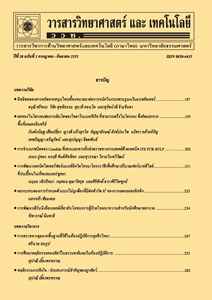การใช้คลอเรลล่าอบแห้งเป็นอาหารสำหรับการเพาะเลี้ยงไรแดงแบบมหมวล
Main Article Content
Abstract
Abstract
This study was carried out to investigate the performance of powdered dried Chlorella sp. as a food source in mass cultivation of water flea (Moina macrocopa) which is the primary important food sources for nursery phase of freshwater fish larvae. Of 4x5 Factorial experiments in Randomized Complete Block Design (20 treatment combinations) with 2 factors; (1) 4 levels of powdered dried Chlorella sp. (PDC; 0.05, 0.10, 0.15 and 0.20 g/L) 2) 5 levels of stocking density of Moina [0.10, 0.15, 0.20, 0.25 and 0.30 g/L (wet weight)] were conducted to compare with fresh Chlorella sp. (FC) at 0.2 g/L (wet weight) stocking density of Moina as a control group for 3 times (replications). Results showed that overall production performances from batch culture at 2-day harvesting (population density, gross production (wet weight) and rate of population increase) were significantly different among all treatments (p < 0.001). Nutritional values between PDC and FC were not different (p > 0.05). The highest production displayed in water flea fed with 0.2 g/L PDC at 0.2 g/L (wet weight) stocking density and was significantly better than water flea raised with FC. Moreover, significantly interaction between PDC level and stocking density were found. These results revealed that stored PDC could be used as food source for mass culture of M. macrocopa when lived Chlorella sp. is limited or unavailable.
Keywords: water flea; powdered dried Chlorella sp.; mass culture
Article Details
References
[2] Mostary, S., Rahman, M.S. and Hossain, M.A., 2007, Culture of rotifer Brachionus angularis Hauer feeding with dried chlorella, Univ. J. Zool. Rajshahi Univ. 26: 73-76.
[3] Islam, M.R., Hassan, M.R., Begum, M., Punom, N.J., Begum, M.K., Sultana, N. and Rahman, M.S., 2017, Effects of feeding zooplankton, Moina macrocopa (Straus, 1820) on the growth of Nile tilapia Oreochromis niloticus L., Bangladesh J. Sci. Ind. Res. 52: 81-88.
[4] Fermin, A.C., 1991, Freshwater cladoceran Moina macrocopa (Strauss) as an alternative live food for rearing sea bass Lates calcarifer (Bloch) fry, J. Appl. Ichthyol. 7: 8-14.
[5] สำนักวิจัยและพัฒนาประมงน้ำจืด, 2554, การผลิตอาหารมีชีวิตจากห้องปฏิบัติการเพื่อการเพาะเลี้ยงสัตว์น้ำจืด, การจัดการความรู้ (KM) สำนักวิจัยและพัฒนาประมงน้ำจืด ปีงบประมาณ 2554, กรมประมง, กรุงเทพฯ, 18 น.
[6] Ivleva, I.V., 1973, Mass cultivation of invertebrates: Biology and methods, Israel Program for Scientific.
[7] Dodson, S.I. and Frey, D.G., 2001, Cladocera and other branchiopoda, pp. 850-914, In Thorp, J.H., Covich, A.P. (Eds.), Ecology and Classification of North American Freshwater Invertebrates, Academic Press, London.
[8] Loh, J.Y., Ong, H.K.A., Hii, Y.S., Smith, T.J., Lock, M.M. and Khoo, G., 2013, Impact of potential food sources on the life table of the cladoceran, Moina macrocopa, Isr. J. Aquacult. Bamid. 65: 1-9.
[9] Zöllner, E., Santer, B., Boersma, M., Hoppe, H.G. and Jürgens, K., 2003, Cascading predation effects of Daphnia and copepods on microbial food web components, Freshw. Biol. 48: 2174-2193.
[10] Malhotra, Y.R. and Langer, S., 1993, Nutritional and density-dependent responses of some cladocera, Aquacult. Res. 24: 631-640.
[11] Martínez-Jerónimo, F. and Gutierrez-Valdivia, A., 1991, Fecundity, reproduction, and growth of Moina macrocopa fed different algae, Hydrobiologia 222: 49-55.
[12] Goldman, J.C., 1979, Outdoor algal mass cultures – II. Photosynthetic yield limitations, Water Res. 13: 119-136.
[13] Martínez-Jerónimo, F. and Espinosa-Chávez, F., 1994, A laboratory-scale system for mass culture of freshwater microalgae in polyethylene bags, J. Appl. Phycol. 6: 423-425.
[14] Becker, E.W., 2007, Micro-algae as a source of protein, Biotechnol. Adv. 25: 207-210.
[15] Priyadarshani, I. and Rath, B., 2012, Commercial and industrial applications of micro algae – A review, JABU 3: 89-100.
[16] Seyfabadi, J., Ramezanpour, Z. and Khoeyi, Z.A., 2011, Protein, fatty acid, and pigment content of Chlorella vulgaris under different light regimes, J. Appl. Phycol. 23: 721-726.
[17] Mangas-Ramı́rez, E., Sarma, S.S.S. and Nandini, S., 2002, Combined effects of algal (Chlorella vulgaris) density and ammonia concentration on the population dynamics of Ceriodaphnia dubia and Moina macrocopa (Cladocera), Ecotoxicol. Environ. Saf. 51: 216-222.
[18] Nandini, S. and Sarma, S.S.S., 2003, Population growth of some genera of cladocerans (Cladocera) in relation to algal food (Chlorella vulgaris) levels, Hydrobiologia 491: 211-219.
[19] Xi, Y.L., Hagiwara, A. and Sakakura, Y., 2005, Combined effects of food level and temperature on life table demography of Moina macrocopa Straus (Cladocera), Int. Rev. Hydrobiol. 90: 546-554.
[20] He, Z.H., Qin, J.G., Wang, Y., Jiang, H. and Wen, Z., 2001, Biology of Moina mongolica (Moinidae, Cladocera) and perspective as live food for marine fish larvae, Hydrobiologia 457: 25-37.
[21] Mostary, S., Rahman, M.S., Mandal, A.S.M.S., Hasan, K.M.M., Rehena, Z. and Basar, S.M.A., 2010, Culture of Brachionus plicatilis feeding with powdered dried Chlorella, Bangladesh Veterinarian 27: 91-98.
[22] Brown, M.R., 1995, Effects of storage and processing on the ascorbic acid content of concentrates prepared from Chaetoceros calcitrans, J. Appl. Phycol. 7: 495-500.
[23] ธนาภรณ์ จิตตปาลพงศ์, 2557, การสร้างสูตรอาหารสัตว์น้ำและสูตรอาหารสัตว์น้ำเศรษฐกิจ, ราชการบริหารส่วนกลาง, กรมประมง, กรุงเทพฯ, 62 น.
[24] El-Sayed, A.F.M., 2003, Effects of fermentation methods on the nutritive value of water hyacinth for Nile tilapia Oreochromis niloticus (L.) fingerlings, Aquaculture 218: 471-478.
[25] Porter, K.G., Gerritsen, J. and Orcutt, J.D., 1982, The effect of food concentration on swimming patterns, feeding behavior, ingestion, assimilation, and respiration by Daphnia, Limnol. Oceanogr. 27: 935-949.
[26] Burak, E.S., 1997, Life tables of Moina macrocopa (Straus) in successive generations under food and temperature adaptation, Hydrobiologia 360: 101-107.
[27] Kang, C.K., Park, H.Y., Kim, M.C. and Lee, W.J., 2006, Use of marine yeasts as an available diet for mass cultures of Moina macrocopa, Aquacult. Res. 37: 1227-1237.
[28] Sarma, S.S.S., Elguea-Sánchez, B. and Nandini, S., 2002, Effect of salinity on competition between the rotifers Brachionus rotundiformis Tschugunoff and Hexarthra jenkinae (De Beauchamp) (Rotifera), Hydrobiologia 474: 183-188.
[29] Poynton, S.L., Dachsel, P., Lehmann, M.J. and Steinberg, C.E., 2013, Culture of the cladoceran Moina macrocopa: Mortality associated with flagellate infection, Aquaculture 416: 374-379.
[30] Abrantes, N. and Gonçalves, F., 2003, The dynamics of Ceriodaphnia pulchella (Cladocera) in laboratory, Acta Oecol. 24: S245-S249.


